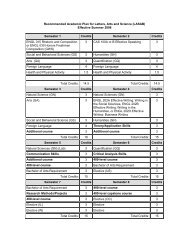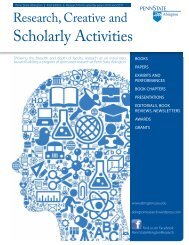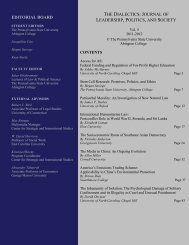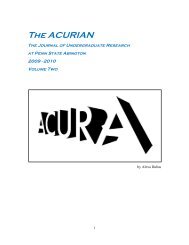Vol. III - Penn State Abington
Vol. III - Penn State Abington
Vol. III - Penn State Abington
You also want an ePaper? Increase the reach of your titles
YUMPU automatically turns print PDFs into web optimized ePapers that Google loves.
esponsible for more than 400,000 civilian deaths, a clear and unfortunate indication that<br />
Ugandans are no strangers to violence. When, in January 1986, Museveni’s army captured the<br />
nation’s capital, Kampala—located in Southern Uganda—he took hold of the government.<br />
Because the UNLA drew the vast majority of its manpower from the Acholi region of Northern<br />
Uganda, many today accuse Museveni of ignoring the needs of the Acholi people. It is<br />
noteworthy that this conflict between the government and the Acholi reflects the North-South<br />
divide that was so prevalent decades before.<br />
Figures other than politicians and army generals have also played a prominent role in the<br />
events that have shaped Uganda’s current conflicts. One such prominent figure was Alice<br />
“Lakwena” Auma, who rose to national prominence in 1985. Auma claimed that she was<br />
channeling the spirit of a dead Italian army officer named “Lakwena” and believed this to be<br />
divinely inspired by Jesus Christ. She thus argued that by seizing national power, she could carry<br />
out her duties of cleansing the Acholi for their sins (the crimes they committed while serving in<br />
the UNLA). Auma called this the Holy Spirit Movement, which quickly gained a group of<br />
followers. Spirituality proved to be an integral part of the Holy Spirit Movement. Auma urged<br />
her followers to smear shea oil on their skin, with the promise that it would serve as a shield<br />
against bullets. Auma’s power was short lived, however, and she fled to Kenya in 1986. Though<br />
her movement faded, Joseph Kony, the founder and current leader of the Lord’s Resistance<br />
Army used Alice Auma as a stepping stone for gaining his own power. In April 1987, he claimed<br />
to be Alice’s cousin and maintained that the spirit “Lakwena” was manifesting itself through<br />
him. Kony’s strategy worked. He attracted many of Auma’s followers, and immediately formed<br />
the Lord’s Salvation Army, which later changed its name to the United Salvation Christian<br />
Army. It became the Lord’s Resistance Army—the name used today—in 1994.<br />
For the past 22 years, Kony has been waging a war on Museveni’s administration. He<br />
still seeks to “cleanse the Acholi,” as did Alice Auma years before. To him, the “cleansing” has<br />
meant massacre. Kony contends that the LRA is fighting for a theocratic state based on The Ten<br />
Commandments, but he has implemented guerilla tactics and has been resistance to peace talks.<br />
Kony’s actions have left many skeptical. According to Robert Gersony, an analyst of the<br />
conflict, “The LRA has no political program or ideology, at least one that the local population<br />
has heard or can understand” (US Embassy in Kampala, Uganda, 1997).<br />
To most, the Lord’s Resistance Army is known for its human rights abuses and its<br />
brutality (cutting off the victims’ lips is done as a LRA trademark). The group’s soldiers are<br />
responsible for the deaths and disfigurement of thousands of Ugandans, Sudanese, and<br />
Congolese, the displacement of two million more, and the abduction of more than 20,000<br />
children, forced to work as child soldiers and sex slaves (Gettleman & Schmitt, 2009). The child<br />
soldiers are physically assaulted and emotionally traumatized. An abducted child interviewed by<br />
the Human Rights Watch reported, “Early on when we were captured, the LRA explained to us<br />
that all five brothers couldn’t serve in the LRA because we would not perform well. So they tied<br />
up my two younger brothers and invited us to watch. Then they beat them with sticks until the<br />
two of them died. They told us it would give us strength to fight. My youngest brother was nine<br />
years old” (Weber, Becker & Rone, 2003).<br />
When the children brought into the LRA are not fighters, they become either a slave, or<br />
they are given to a commander as a wife. The treatment of wives varies: some claim they are<br />
being treated much better than when they were slaves, but many report having been beaten daily.<br />
At World Vision—a rehabilitation center in Northern Uganda—nearly 85% of all children<br />
receiving care have one or more STD, most frequently syphilis and gonorrhea. What’s worse is<br />
THE DIALECTICS ▲ 2009<br />
www.abington.psu.edu/dialectics<br />
9







